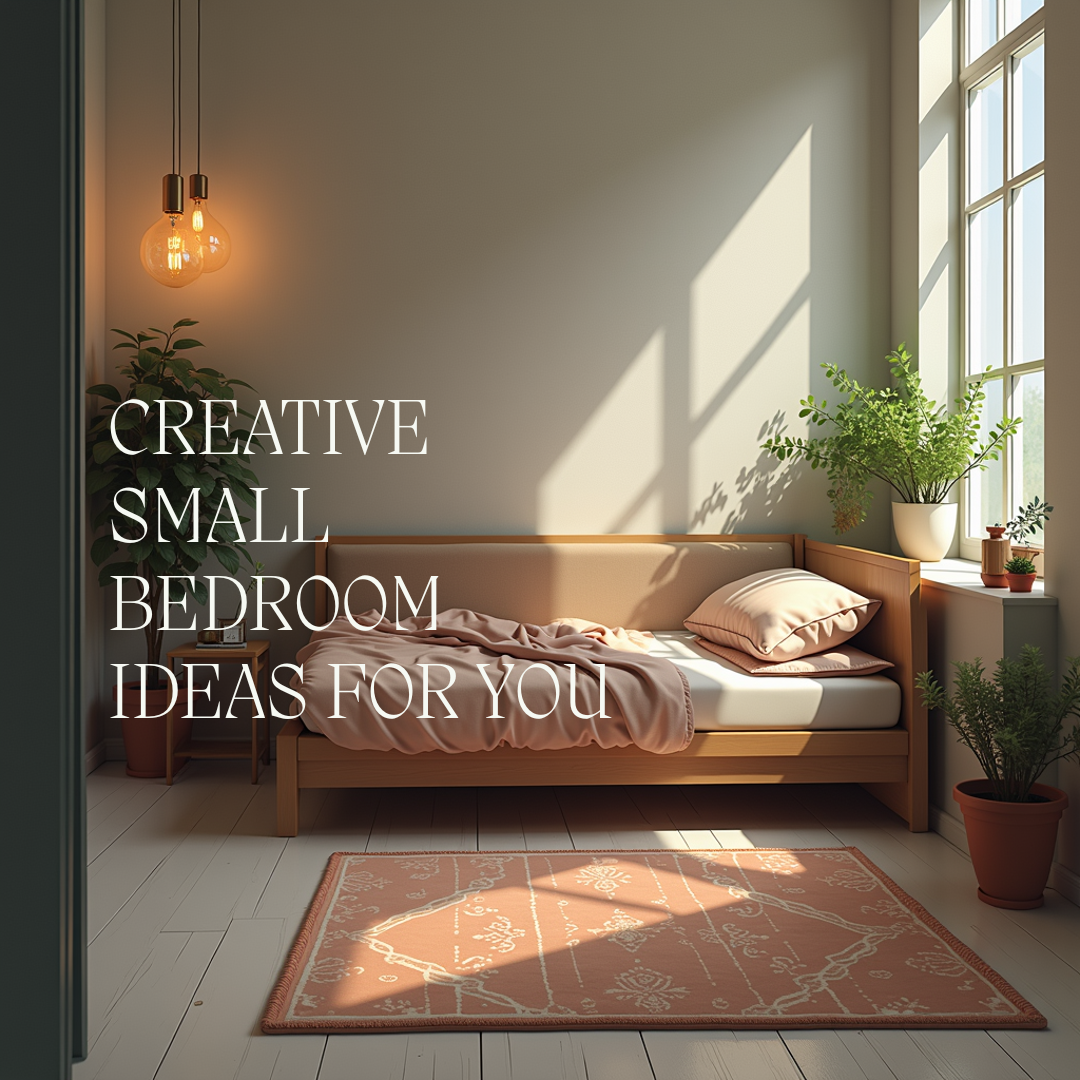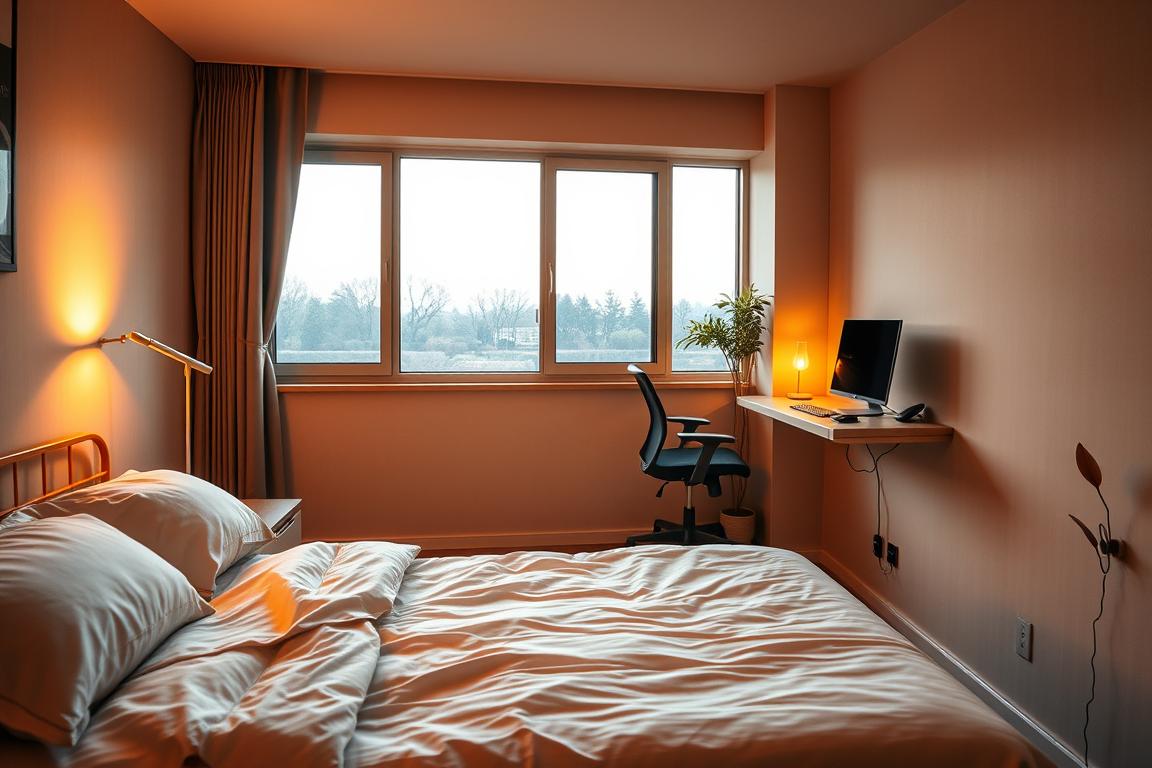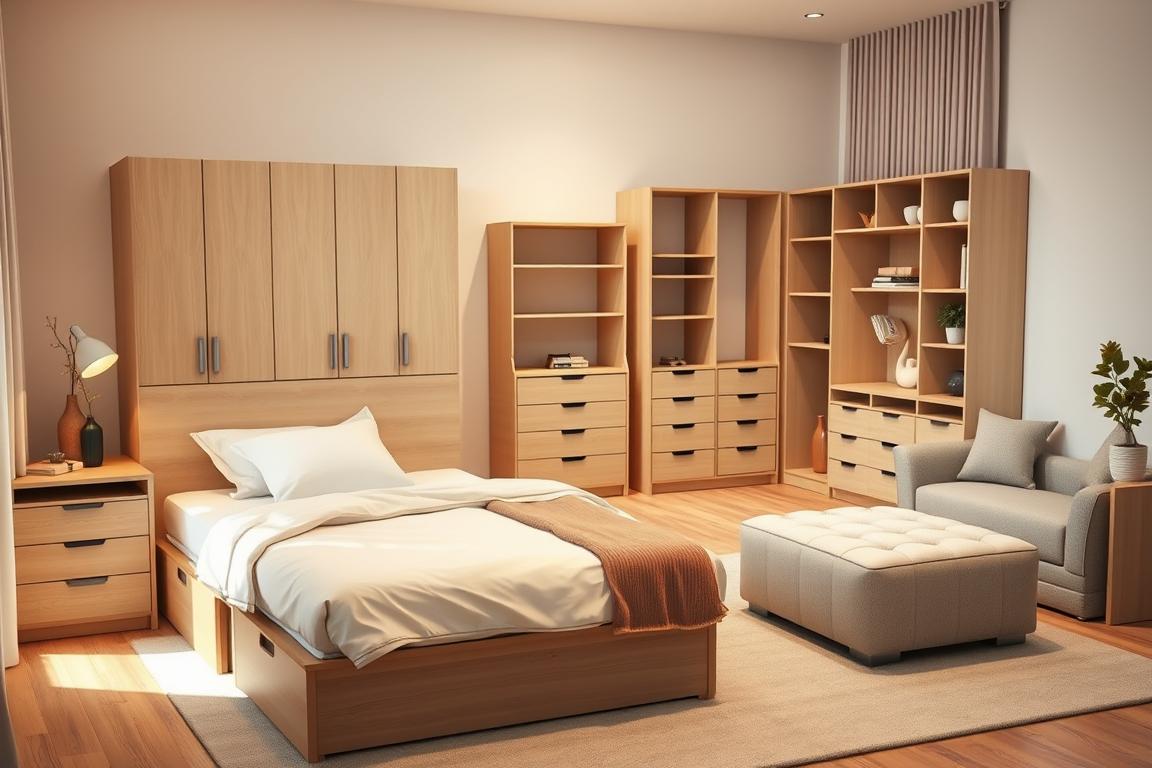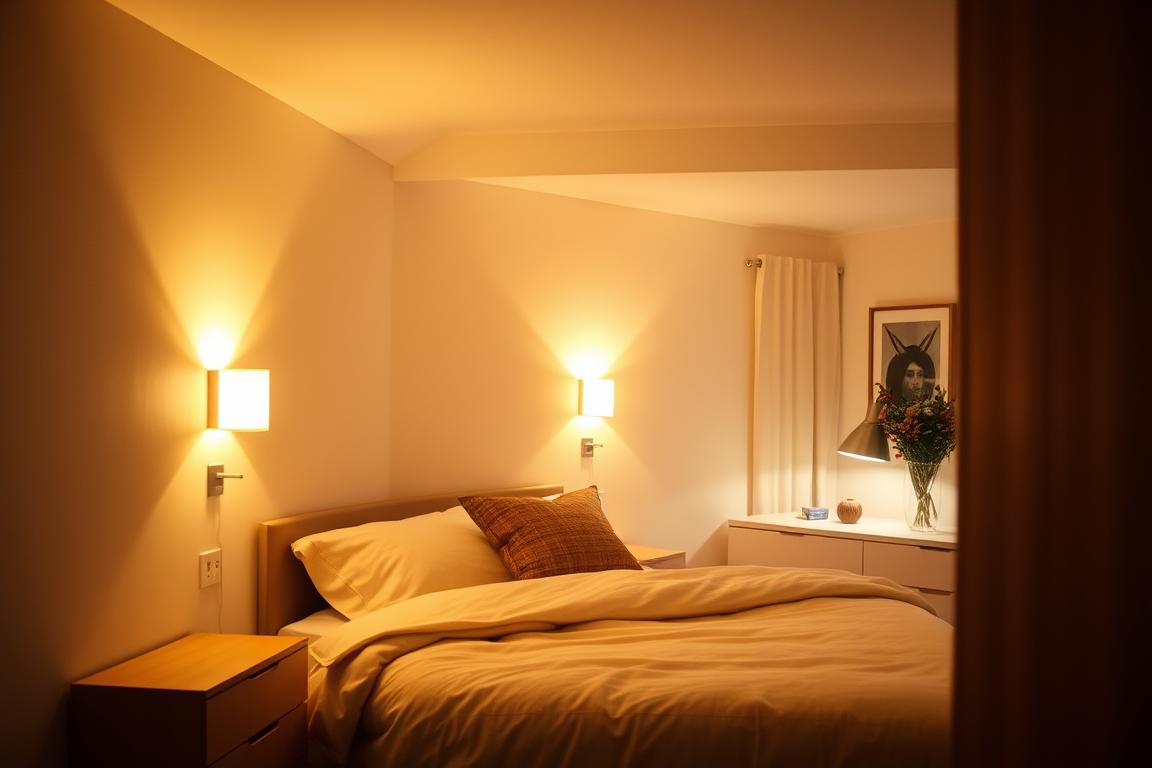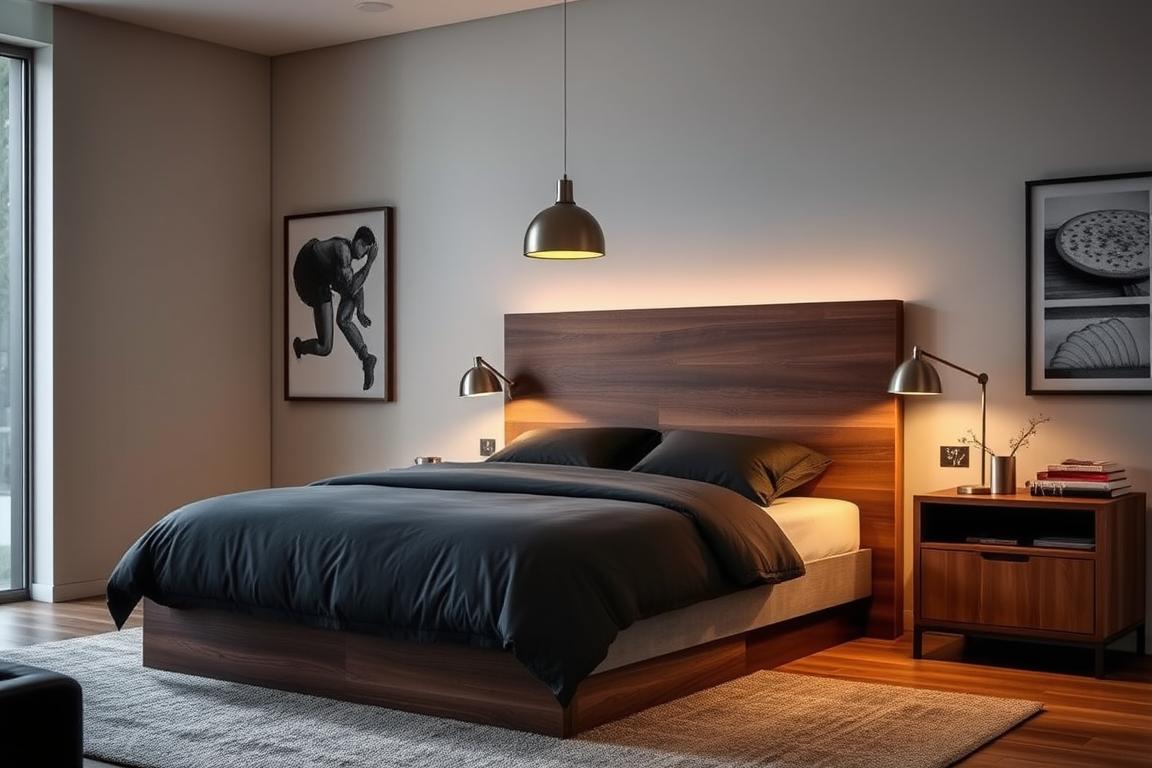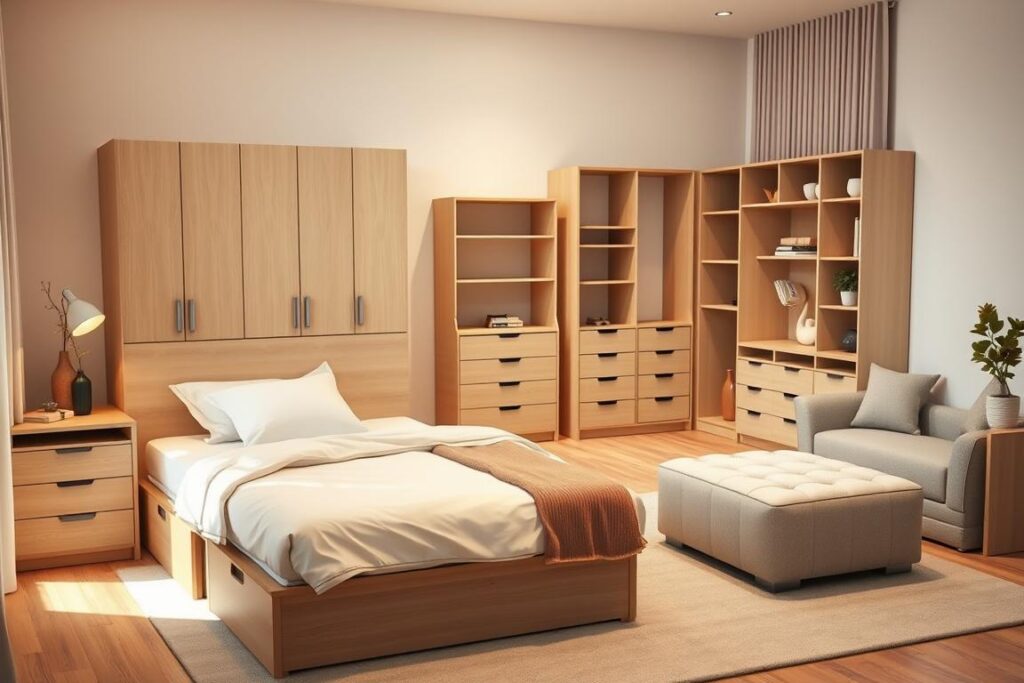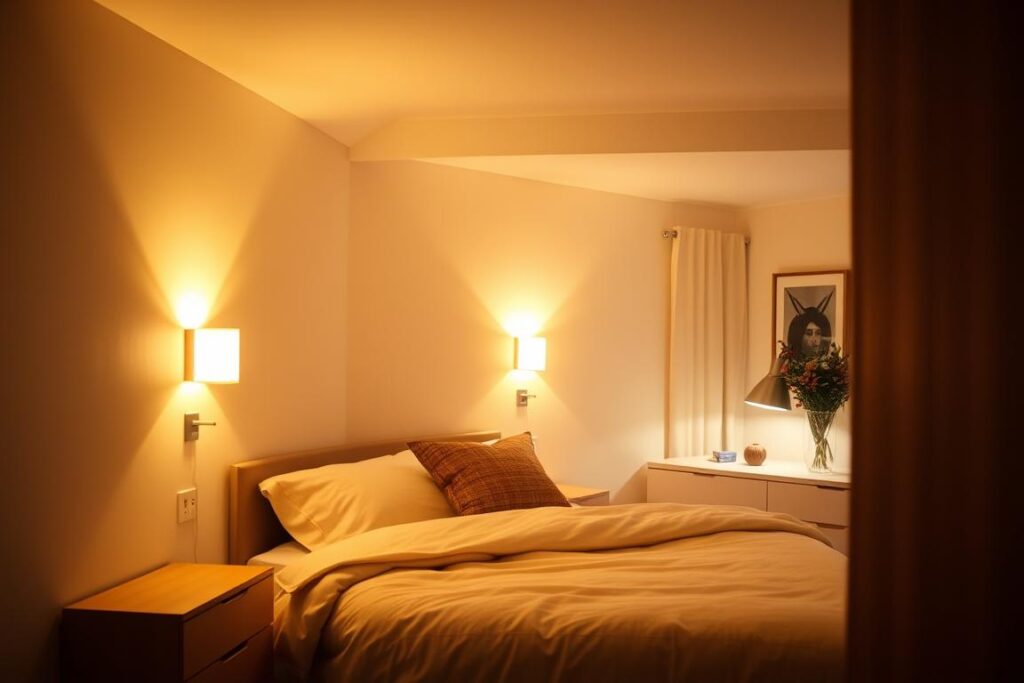Cozy Bedroom Lighting: 7 Brilliant Ideas for a Restful Glow
Cozy Bedroom Lighting transforms how you feel the moment you enter—layer soft, indirect light and add dimmers so the room shifts from task-ready to deeply relaxing in seconds.
Updated 2025. Start with warm 2700K bulbs and diffusing shades in linen or opal glass. Use bedside lamps sized for reading comfort, wall sconces to save space, and subtle LED accents for depth—each on separate controls so you can fine-tune mood and brightness. For an overview of approaches, see our Bedroom Lighting Ideas guide.

Caption: A 2700K base layer creates a warm, restful glow without glare.
Key Takeaways
- Layer lights—combine ambient, task, and accent instead of a single overhead source.
- Choose 2700K bulbs and diffusing shades for a soft, flattering glow that supports wind-down.
- Put fixtures on dimmers and split circuits to switch quickly between read, relax, and sleep scenes.
- Cozy Bedroom Lighting works best with compact fixtures that preserve flow in small rooms.
- Blend efficient LEDs with warm finishes to save energy without losing atmosphere.
Set the Mood with Layered Light: Ambient, Task, and Accent
Begin with a gentle base layer, then add focused light where you need it and a touch of accent for depth. Layers prevent glare and make even a tiny room feel calm and intentional.
Ambient: Create the overall glow with shaded pendants, semi-flush fixtures, or indirect cove lighting that avoids harsh downlight.
Task: Place wall sconces or adjustable lamps at the bed and desk so you can aim light for reading or journaling without shining into eyes.
Accent: Use LED strips behind a headboard, art washes, or shelf highlights to add dimension without over-brightness.
- Ambient → base atmosphere with shaded pendants, semi-flush, or cove lights.
- Task → focused reading light with wall sconces, swing-arm, or desk lamps.
- Accent → depth and focal points with headboard LEDs, picture washes, and shelf pucks.
Put each layer on its own switch plus a dimmer to tune the mood—bright for tidying, medium for winding down, and low for pre-sleep calm. For compact rooms, choose fixtures that hug the wall or ceiling and keep traffic paths clear.
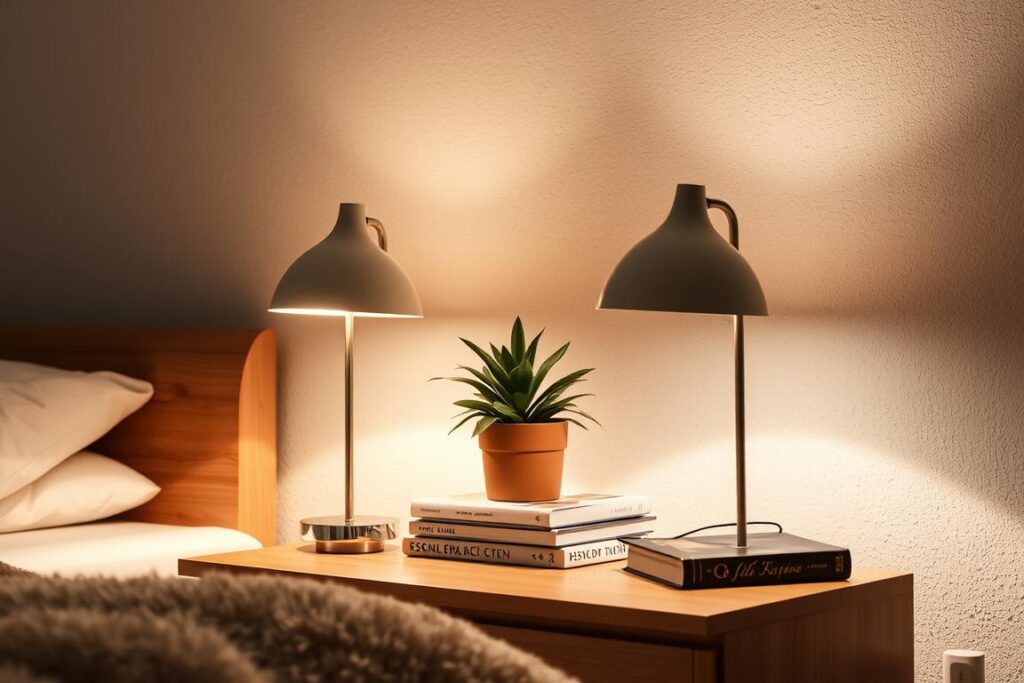
Caption: Diffusing shades and dimmers create reading light without waking your partner.
Choose Warm Color Temperatures and Dimmers for a Soft, Restful Glow
Pick one consistent bulb tone first, then add controls. 2700K warm-white typically feels gentler at night. It keeps blue-rich output lower than cooler bulbs, which helps your eyes and mind wind down.
Pair those bulbs with linen or opal glass diffusers so the glow is enveloping, not piercing. Avoid exposed bulbs that create glare.
Sleep matters: most adults need at least seven hours nightly, so lighting that supports wind-down can help your routine (CDC sleep guidance). Light exposure influences circadian cues; keep it warm and dim near bedtime (National Sleep Foundation on light & sleep).
Add dimmers and separate switches for precise mood control
Use triac or smart dimmers to slide from task-ready brightness to a low, soothing ambiance without swapping bulbs. Split ambient, task, and accent lights across separate switches so you illuminate only what you need.
- 2700K warm-white: supports evening relaxation; seek 80+ CRI for natural skin tones.
- Diffusers & shades: opal glass, linen, or parchment to soften edges and even the glow.
- Dimmers & separate circuits: multi-gang or smart scenes for quick control.
Shopping for healthier materials? Skim trusted roundups of non-toxic bedding and mattress picks and look for foam certifications like CertiPUR-US® when relevant.
Bedside Brilliance: Lamps, Wall Sconces, and Pendants
A smart bedside plan gives you task-ready light and frees space for water, books, and chargers.
Table lamps: Size them about 25–29 inches so the beam clears your shoulder and lands on the page. Keep the table within 4–5 inches of the bed and near mattress height for easy reach. See our Bedside Lighting Ideas.
Bedside lamp shapes and dual-bulb options
Choose soft-profile shapes like gourd or urn to limit hard edges in view. Dual-bulb bases or two-level switches give you a bright task setting and a low nightlight without changing lamps.
Space-saving wall sconces with adjustable arms
Wall sconces with swing arms save surface area and aim light precisely for reading. Mount one per side of the bed so both sleepers enjoy independent control.
Plug-in pendants to free nightstand space
Plug-in pendants and sconces work well in rentals. Hang a pendant low over each side to clear the nightstand and keep cords tidy with simple covers.

Caption: Hidden LEDs add depth while keeping brightness gentle and controllable.
LED Ideas That Instantly Cozy Up Your Room
Backlit headboards for a halo effect
Create a soft halo that centers the bed and dims for late-night calm. Mount strips behind the headboard or along the wall for bounce light.
Under-bed lighting for a floating, night-friendly glow
Motion-activated strips guide night trips and make the bed appear to float. They brighten the floor without waking a partner.
LED panels and ceiling accents that diffuse light
Perimeter strips or slim panels deliver even glow. Use warm presets in the evening and brighter settings for daytime tasks.
Mirror and nook illumination to add depth and function
Edge-lit mirrors remove shadows for grooming, while shelf LEDs highlight objects and create focused reading corners.
Cozy Bedroom Lighting Ideas that Maximize Space
Choose fixtures that add light without adding visual weight. Keep paths open and the ceiling clear.
Flush & semi-flush: Sit close to the ceiling to deliver even ambient light and preserve headroom.
Recessed & track: Keep the ceiling clean and aim light where the room needs it most—desk, closet, or reading nook.
Mini pendants & compact chandeliers: Create a focal point without overwhelm. Airy shades or rattan help bounce light and maintain brightness.
- Start with a flush or semi-flush for ambient coverage.
- Add recessed or track to steer light exactly where needed.
- Use adjustable wall sconces to free nightstands and direct beams for reading.
- Match warm LED bulbs across fixtures so everything feels cohesive.
Want a quick walkthrough? Browse layout tips inside our Bedroom Lighting Ideas and our Best LED Lighting Bedroom Ideas.
Materials, Shades, and Finishes that Help Create a Cozy Atmosphere
Let textured fabrics and opal glass do the heavy lifting to soften light. Repeating finishes adds calm, while a small contrast keeps interest.
Linen, parchment, and opal glass: Turn harsh points into an even, gentle glow that helps eyes relax at night.
Brass and patinated metals: Add subtle warmth; repeat finishes across hardware and fixtures to unify your look.
- Match metal tones for a curated feel, or mix compatible textures for interest.
- Pair warm finishes with warm color temperatures for a seamless glow.
- Use fabrics and translucent glass to add scale without crowding a small space.
Quick Visual: Bedroom Light Levels Guide
This simple guide helps you target brightness without overdoing it in a cozy bedroom.
- Ambient: 1,000–2,000 lumens total for small rooms; 2,000–3,000 lumens for larger rooms.
- Bedside task: 300–500 lumens per side, with shades to reduce glare.
- Accent: 50–200 lumens per feature; dimmable for evening comfort.
For more space planning, see our Small Bedroom Layout Ideas.
FAQ
What is the best lighting for a cozy bedroom?
Layered lighting works best: a soft ambient base, targeted task lights at the bed, and a touch of accent for depth. Keep everything dimmable and warm, around 2700K, for night comfort.
Is 2700K or 3000K better for bedrooms?
Both can work, but 2700K usually feels cozier at night. If you prefer a crisper look by day, choose tunable LEDs and dim to warmer settings in the evening.
Where should bedside sconces be mounted?
Mount them roughly at seated eye level and to each side of the headboard so the beam hits your book, not your partner. Adjustable arms improve aim and comfort.
How many lumens do I need in a small bedroom?
A practical range is 1,000–2,000 lumens for ambient light, plus focused task light at the bed (300–500 lumens per side). Dimmers help tailor brightness to the task.
Conclusion
Finish by arranging layers so the room moves easily from task-ready to restful with one set of simple controls.
Keep the plan practical: warm 2700K bulbs, diffusing shades, and dimmers for a soft glow that reduces glare and supports sleep. Right-size bedside fixtures, add wall sconces or plug-in pendants to free space, and use subtle LEDs—backlit headboards, under-bed strips, mirror and nook lighting—for depth without clutter. For even more Cozy Bedroom Lighting ideas, browse Cozy Bed Quarters’ latest guides.


